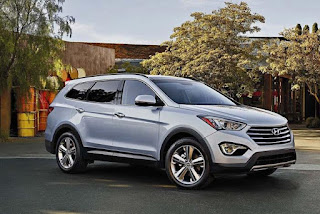If you’re like me, wandering
through the hundreds of models and trim levels available in the automotive
marketplace sometimes feels like meandering through a maze.
So it’s no surprise that
once in a while you come across something different that’s, well, a-mazing.
Then you look a little
closer and come across the Santa Fe Sport, smaller than the 7-passenger Santa Fe but larger than the compact
Tucson. It begs the question of where it fits in the showroom.
The Sport’s biggest drawback
might be that it gets lost in marketing as the baby sibling to the full-size Santa Fe.
Many buyers might be quite comfortable in a nicely refined Santa Fe Sport,
which can comfortably accommodate four adults (five in a pinch) along with
their luggage.
Our test vehicle was a 2015
Santa Fe Sport AWD. It’s 8.4 inches shorter than the regular Santa Fe and 11.4
inches longer than the Tucson.
The Sport is available in
base or 2.0T trims. The base is powered with a 2.4-liter 4-cylinder engine (190
horsepower, 181 lb.-ft. of torque). Our 2.0T had the optional 2-liter turbo
that produces 264 HP and 269 lb.-ft.
In normal driving, we found
the turbocharged engine quite refined and happily mated to the six-speed
automatic transmission that serves both engines.
In several passing
situations, the engine-transmission combo seemed to search for the right gear
for an instant, and then took off with excellent real-world performance.
EPA ratings for the 2.0T are
18 miles per gallon in city driving, 24 on the highway, and 21 overall.
Our first tank of gas
averaged 23.9 mpg. After refueling for the New Hampshire trip, the onboard
computer claimed we’d averaged 31.2 mpg for 120 miles of easy driving. That
seemed overly optimistic, but it was an eye-opener and a nice surprise, even
when gas was $2.34 per gallon.
 Compact SUVs are a hot
market item and they make driving easier with their higher seating positions.
Compact SUVs are a hot
market item and they make driving easier with their higher seating positions.
The leather-covered, heated
(and ventilated) front seats were quite comfortable. Rear seats (also heated)
had a big center armrest and were just right for two adult passengers.
Inside the cabin, the
leather and vinyl surfaces were attractive, and there were lots of well-marked
buttons. In fact, if there had been a tuning knob for the audio system, I’d
have been totally impressed.
The Blue Link telematics
work well with the eight-inch touch screen that’s part of the navigation system
and was as user-friendly as any on the market.
Hyundai came up with a slick
gauge layout with two big dials (speedometer and the unnecessary tachometer).
In the middle of the speedometer was a raised circle that displayed the outside
temperature. Around that temperature readout was a circle of dotted lines that
was the gas gauge. Unfortunately, it’s in light gray and not well lit so you
may overlook it. I did until Mrs. G, as is her wont on trips, quietly inquired,
“Do we have enough gas to get home?”
It would have been close.
Inside the tachometer was
the same setup. Here, the center readout was the gear (P, R, N, D) unless you
flip the shift lever to manual mode. Then the display shows the gear number
(1-6). A circular water temperature gauge matches the fuel gauge.
On the road, the Sport had a
sure feel. Hyundai (remember
it rhymes with Sunday) says it’s done some serious tweaking with the electric power-steering
response, and it shows. The Santa Fe Sport was a joy on winding roads.
The HID headlights were
welcome now that the days are getting shorter and nighttime driving is
unavoidable.
You can count me among those
who say these small crossovers “all look the same” in their basic shape.
That also means that rear
visibility isn’t the best, so the Sport’s standard rearview camera was most
welcome in our test vehicle. Hyundai
has an added twist on the blind-spot monitoring system. In addition to the
traditional “two-cars” symbol that lights in the outside mirrors, there’s an
audible alert if you try to change lanes with a car close behind in that lane.
Of course, it’s based on distance so the buzzer also goes off when you change
lanes while barely creeping along in bumper-to-bumper traffic.
Base price was $33,875
(including destination). A $4,350 Ultimate Package added 19-inch alloy wheels,
panoramic sunroof, HID headlights and LED taillights, navigation with
eight-inch touch screen, memory seats, upgraded audio system, the ventilated
front and heated rear seats, rear parking sensors, and heated steering wheel.
Toss in carpets ($125) and
you get a $38,350 bottom line.
That puts our test vehicle
into a fully equipped near-premium category.
What’s amazing isn’t so much
where Hyundai is today but how far it’s come in the past 30 years, building
cars that reflect the five-year, 60,000-mile new vehicle warranty and 10-year,
100,000-mile powertrain warranty.
This turned out to be a “The
more you drive it, the more you like it” vehicle.
2015 Hyundai Santa Fe Sport
AWD 2.0T
THE BASICS
Price, base/as tested (with
destination): $33,875/$38,350. Fuel economy, EPA estimated: 18 city, 24
highway, 21 combined. Fuel economy, Globe observed: 23.9. Drivetrain: 2.0-liter
turbo 4-cylinder, 6-speed automatic transmission, all-wheel-drive. Body: 5-passenger
crossover.
THE SPECIFICS
Horsepower: 264. Torque: 269
lb.-ft. Overall length: 184.6 in. Wheelbase: 106.3 in. Height: 66.5 in. (with
racks). Width: 74 in. Curb weight: 3,706 lbs.
THE GOOD
Build quality, warranty,
handling, and suspension.
THE BAD
Rear visibility, some gauges
hard to read.
THE BOTTOM LINE
A nice “tweener” bridging
the compact and midsize segments. ALSO CONSIDER Audi Q3, Ford Escape, Honda
CR-V, Mazda CX-5, Nissan Rogue, Toyota RAV4.

No comments:
Post a Comment